Wishing A Happy And Healthy Holiday to All!
From All of Us at the Washington Glass School.
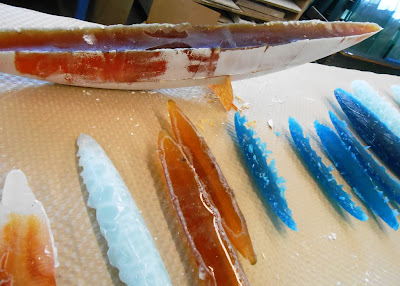 |
| Artist Syl Mathis divests his glass forms from the plaster after kilncasting the glass. |
The artists & instructors of the Washington Glass School are busy beavering away creating new works for the upcoming Holiday Open House and sale, scheduled for Dec 14th, 2013, from Noon til 5:00 PM.
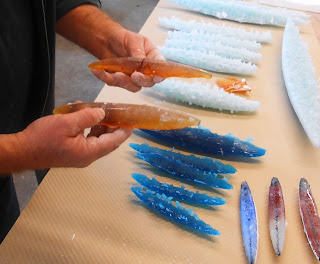 |
| Syl casts the forms and then sandcarves and coldworks his shapes. |
| Syl Mathis “Artifact #14” 32″ x 3.5″w x 2″d |
The December 14th open house has more in store! Adjacent Flux Studios also has their Open Studio, as well as their First Annual Cup Invitational! Must see works – by superstar artists – in some of most fun studios you will ever see! Mark your calendars at once!
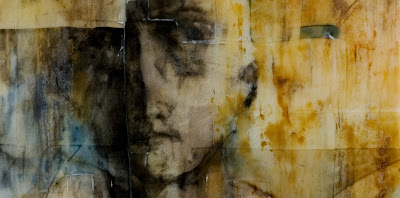 |
| Jeff Wallin “Improvised Mirror” detail, kilnformed glass. Photo: Michael Schmitt. |
Our second profile in the “Artists To Watch” series is Jeff Wallin.
Jeff has spent his life in the Pacific Northwest. He studied under Professor Keiko Hara at Whitman College, graduating in 1995 with a B.A. in Studio Art. Jeff continued to pursue drawing and painting after moving to Portland, OR.
Jeff Wallin’s introduction to glass came in 1999 at Ray Ahlgren’s FireArt Glass studio, where Jeff continues to work, gaining new understandings in how to apply the challenging medium of glass to his ongoing exploration of the human form. Jeff’s work has been reviewed in the Urban Glass Quarterly, and his work was selected for publication in the Corning New Glass Review. In 2013, he was a teaching assistant for Jessica Loughlin and Kirstie Rea at the Pilchuck School of Glass.
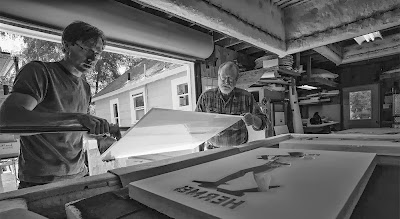 |
| Jeff Wallin and Ray Ahlgren of FireArt Glass create the glass door panels for the US Library of Congress. Photo: Charlie Liebermann. Click HERE to jump to American Craft article on the historic architectural artwork project. |
Says Jeff of his work in an architectural glass studio: ” I feel my work [with Ray Ahlgren’s Fire Art Glass Studio] impacts my personal art work, and vice versa. I often say that working with Ray and being constantly exposed to new projects (even though the work may not apparently have a direct bearing on my approach to art) leads to a level of familiarity with the material that allows me to work more intuitively without getting hung up on the highly technical nature of glass. It helps to understand when being precise is critical to success, and when it’s just getting in the way. Plus, I think it keeps me looking with fresh eyes at both the projects at Fire Art and my own studio artwork.”
.jpg) |
| Jeff Wallin, “Lucretia – After Rembrandt”, kilnformed glass. Photo: Michael Schmitt. |
Taking inspiration from emotionally and psychologically complex figure painters such as Francis Bacon and Lucien Frued, Jeff’s portraits have the marks of a painter’s perspective and a painter’s intuition, the relaying of an idea by brush– all that expressed in the language of glass.
 |
| Jeff Wallin, “Judgement (Study from Gentileschi)”, kilnformed glass. Photo: Michael Schmitt. |
Talking about how he uses glass to create painterly works of art, Jeff said: “For my investigation of the human form, glass offers an incredible medium for exploring my relationship to this subject. My methods of kiln forming purposefully ignore most of the strict adherence to process normally associated with the medium. The work is driven to completion as part of a dialogue, which begins as a response to the model and then develops in unexpected ways as the work matures over multiple firings in the kiln. My intent is to maintain an attitude of spontaneity and preserve the raw moment when the piece first began…There are no conclusions, only possibilities.”
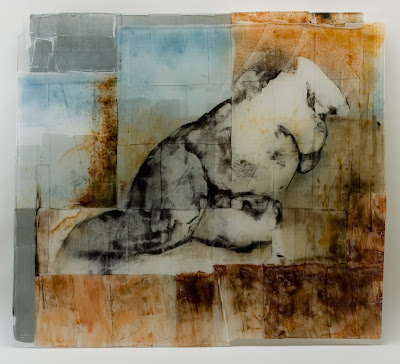 |
| Jeff Wallin, “Classical Study”, kilnformed glass. Photo: Michael Schmidtt |
Jeff has a solo show that opens at Stewart Fine Art in Boca Raton, Florida that opens this week.
Gallery owner Sonny Stewart said of Jeff’s work: ” [Jeff] is a classically trained artist – the compositions of his work show his knowledge and sensitives… His artwork explores many of the concerns of contemporary painting, but does this exploration with glass. Painting exists in a continuum with centuries of tradition while simultaneously embracing aspects of sculpture, installation and collage… [Jeff’s art] goes beyond pigment on a surface; it’s an approach to making imagery that encompasses the ways in which a material is used to construct the work, how the subject is approached, and even how the idea of the subject is concieved.”
Stewart Fine Art
608 Banyan Trail, Boca Raton, FL
Jeff Wallin “Glass in the Classical Sense“
November 14 – December 11
Opening Reception November 14, 2013
| Syl Mathis |
The Bethesda Row Arts Festival is this weekend – turning downtown Bethesda into an outdoor art gallery featuring fine arts and crafts from 190 artists in the Bethesda Row area of Bethesda, Maryland.
| Syl Mathis |
Our Syl Mathis is one of the featured artists in the show – with some spectacular new kiln cast glass sculptures.
| Syl Mathis |
SHOW INFORMATION
16th Annual 2013 Bethesda Row Arts Festival
Saturday, October 19th – 11 a.m. – 6 p.m.
Sunday, October 20th – 10 a.m. – 5 p.m.
Admission is FREE.
The outdoor event is held rain or shine on Bethesda Row located on Woodmont and Bethesda Avenues, Elm Street. The festival is near the Bethesda Metro station.
 |
| Grind, Jenny, Grind! |
In a recent post, we showed Jenny Lindstrom working on a new mixed media artwork – and that we’d post images of the completed work. Jenny’s work often mixes found objects with cast glass and aluminum elements.
 |
| Jennifer Lindstrom’s cast glass and mixed media sculpture in the 2011 WGS 10 Year anniversary exhibit at Longview Gallery. Photo: Pete Duvall. |
Jenny often creates cast glass sculpture forms that resemble houses and plays off the rough and smooth finishes. Below are some of the photos by photog James Calder of her newest work to be part of her portfolio of work submitted to Penland :
 |
| Detail of Jennifer Lindstrom’s cast glass house. Photo James Calder. |
From glass and video sculptor Tim Tate:
Three Current Pieces That Discuss The Transition From Studio Glass To Glass Secessionism
I see my sculptures as self-contained installations. My current work chronicles the transition from the Era of Studio Glass to the new movement of Glass Secessionism.
Blending a traditional craft with new media technology gives me the framework in which I fit my artistic narrative; contemporary, yet with the aesthetic of Victorian techno-fetishism.
To see this chronology, I will discuss 3 of my recent artworks.
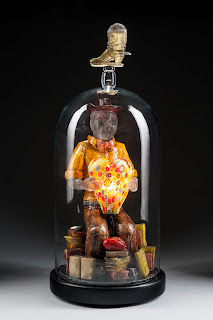 |
| Tim Tate “Cowboy Luvin” blown and cast glass, LED lighting. |
In Cowboy Luvin’ I reinterpret a millefiori lamp that belonged to my grandmother, though up date its narrative content and technology to LED’s. This was specifically made to show Secessionist roots in early glass.
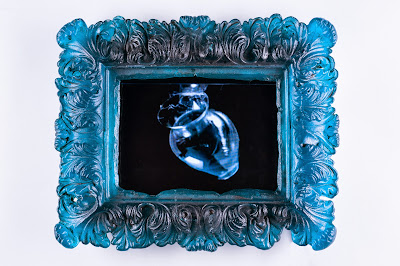 |
| Tim Tate “Smashing Blue” cast glass, video, electronics. |
In the Smashing Blue piece, I use a time-based medium (video) to show a glass vase smashing, yet then reconfiguring again and again. This is intended to show that our definitions in the 20th century ebb and flow towards what is and isn’t glass based, and how we are constantly redefining the present dialog.
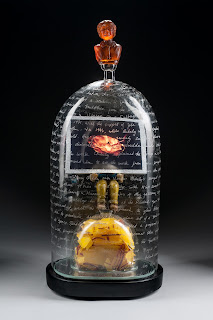 |
| Tim Tate “The Next 50 Years Begins Now”, blown and cast glass, video, electronics, engraving |
In The Next 50 Years Begins Now a video shows the smashing of a Chihuly-like glass piece, and then reconfiguring over and over. Inside the smaller dome are shards from the original piece. On top of that is a small man holding a large video screen, playing that video. The cast glass finial on top is a bust of Dale Chihuly. The surface of the outer dome has been etched with the history of Dale Chihuly, his importance to the Studio Glass and the artworld, and the text ends with his suing his former assistant for knocking him off.
This piece asks many questions:
Is this real?
> A fake?
The culmination of 30 years of work?
> Or just glass and 3 hours time?
The beginning of glass secessionism?
> Is glass secessionism the right term?
Does this mark the end of technique driven dominance?
> Or the beginning of ironic work?
Does breaking this piece add value to it?
> Or does it destroy it?
If this was a cheap knock off, who would be wielding that hammer?
Does questioning authority equal disrespect?
Could this be an act of construction, not destruction…just as I intended it to be?
To me, these works are phylacteries of sorts, the transparent reliquaries in which bits of saints’ bones or hair — relics — are displayed. In many cultures and religions, relics are believed to have healing powers. My relics are temporal, sounds and moving images formally enshrined, encapsulating experiences like cultural specimens. And perhaps, to the contemporary soul, they are no less reliquaries than those containing the bones of a saint.
With technology rapidly changing the way we perceive art, the current day contemporary landscape closely mirrors Victorian times in the arts. We marvel at and invent bridges between past and present in an effort to define our time and make sense of this highly transitory moment in artistic history.
Tim Tate
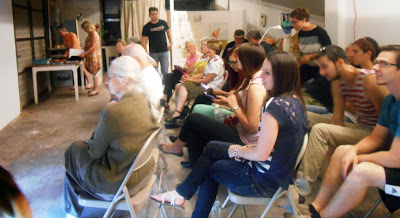 |
| The audience gets settled into Flux Studios for the start of the history of American studio glass. |
Professor Debra Ruzinsky’s lecture on the history of the studio glass movement was a treat! Debra’s slide lecture outlined the traditional lineage and then featured many of the artists and works not normally included in the standard time line history that starts in March 1962 and focuses primarliy on blown glass works. Deb’s discussion included pre-’60s and ’70s works, works by women, European glass artists, kiln casters, and narrative works – all the alternate viewpoints.
 |
| Debra Ruzinsky’s lecture takes the students on a journey. |
Novie Trump of Flux studios offered the use of their stunning space for the talk, and it was SRO – which is always heartening.
 |
| Tim Tate addresses the students from Salisbury University glass program that traveled hours to be part of the talk. |
Assistant professor Steve Durow arranged for a group from the glass program at Maryland’s Salisbury University to join the lecture and the students had a tour of the glass school. The idea that the young-un’s (as well as us old coots) are getting a sense of the rich history of glass as the medium rushes forward into the 21st Century makes all of us at the Glass School happy.
Want to know what is entailed in the Affordable Care Act (aka ObamaCare?)
Gateway CDC will host a workshop on Thursday, October 24 from 7:00 to 9:00 PM
Location: 39th Street Gallery at 3901 Rhode Island Ave. (Second Floor 39th Street entrance) Brentwood, MD 20722
|
 |
| Sean Hennessy “The Luxury of Dreams” |
The Luxury of Dreams is a series of artworks based on interpretations of dreams submitted to Sean by friends, colleagues, strangers, and social media connections. Using bas-relief cast glass, painting, drawing, and photography, Sean has created a strong and surreal body of works that takes his work to a new level. Based on the situation of the homelessness in DC, this exhibit of dreams will also serve as a fundraiser for charity organization Thrive DC, who perform services for those in need of our Nation’s Capitol.
 |
| Sean Hennessey |
Sean Hennessey’s “The Luxury of Dreams” came about after a personal experience with a neighborhood homeless man who, with help, was able to turn his life around. Using the crisis of homelessness in our cities came a desire to create an exhibition based on blankets, beds, and shelter. About this, Sean wrote: “I then wondered if the level of security of having a place to sleep affected how we dream. I was thinking about how we all enter the world of dreams, regardless of where we sleep. I thought that I would create a series of works based on the dreams of others. Through conversations … about art and social issues, my idea for The Luxury of Dreams series was born. I started soliciting dreams from friends, colleagues, collectors, other artists, and social media connections.”
 |
| Sean Hennessey |
Sean works in glass, concrete, steel, light and video, creating narrative content from philosophical, mythological, historical and personal experiences.
Said Sean: “As I was dealing with an uncomfortable issue in the inspiration of this series, and a new way of developing content within my work, I wanted to take a new approach to the creation of the work itself. I decided that I would utilize photography and drawings into glass. After receiving many dreams from friends and strangers I began conceptualizing how I would approach the pieces. At first I thought I would layer photos and drawings with castings of glass Beds and Blankets. I may still create a series in that direction, but I decided for this first series based on dreams that I would pick imagery from the dreams that I felt most connected and relate it to my way of storytelling. Atypical of how I approach a series, each piece will feel different and have different shapes and sizes. I usually like for my series to read like a book, often with each piece the same size and scale; another new way of making work for me.”
The Luxury of Dreams
Opening: Friday, October 4, 7-10pm
Exhibition Dates: October 4-November 15
Washington, DC 20010
The gallery is located on the second floor. It is 0.3 miles from the Columbia Heights Metro, and there is ample parking in the DC USA building. Click HERE to jump to the event Facebook page.
 |
| © Erwin Eisch / CMOG |
Whats going on in the photo above?
Is it a new 8 member boy band created from TV show “X Factor”? No.
Still photo from the latest sequel to a Hollywood slasher/gore film? Nope.
Some Portland hipsters gathering at a coffee café that doubles as a low-carbon-footprint bike shop? Wrong Again.
European glass innovator Erwin Eisch made the 8 mold blown works as a tribute to Harvey Littleton in 1976. Eisch’s non-traditional approach to glassmaking had a profound impact during the formative years of the American Studio Glass movement, and his relationship with American glass pioneer Harvey K. Littleton forged an important link between European and American studio artists working in glass.
Want to know more about the history of Studio Glass? This Saturday, October, 5, from 1 pm, the Debra Ruzinsky of the Washington Glass School will talk and show images presenting a broad international survey rooted in the early days of studio work. Works by artists Sybren Valkema, Edris Eckhardt, Michael and Francis Higgins, Libensky and Brychtova, Ann Wolff, Erwin Eisch, Kyohei Fujita, Vera Liskova, to name a few early & influential artists — such as female glass artist Asa Brandt, who has been called the “Harvey Littleton of Sweden”.
This free talk is a great way to know who and where glass has come as we move boldly into a new future of the medium.
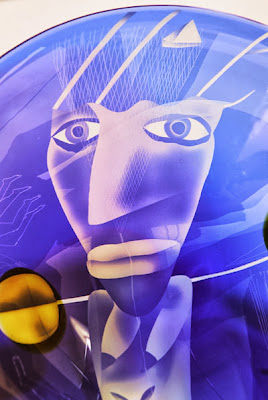 |
| BLUE MADONNA by Ann Wolff |
What Came Before / A Slide History Of The Studio Glass Movement
Lecturer : Debra Ruzinsky
When : Saturday,October 5th
From:1 pm
Cost : Free of charge…RSVP to: washglassschool@aol.com
Where: Washington Glass School
3700 Otis Street, Mount Rainier, MD 20712
Oh, and the titles of the Erwin Eisch heads:
(A) Littleton the Gentleman: mirrored inside, with glasses, with marble base. (B) Littleton the Poet: with glasses and beanie. (C) Littleton the Teacher: mirrored inside, glassblower painted on right side of head; set on square black base. (D) Littleton, Man of Frauenau: cold painted in facial area and around base with scene of town. (E) Littleton the Worker: applied band of colorless glass across nose and around head, square black base. (F) Littleton’s Headache: painted with bandages surrounding head and chin area, etched in other areas, square black base. (G) Littleton the Fragile. (H) Littleton’s Spirit: with collar and tie.